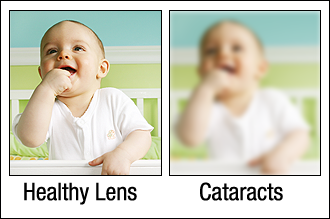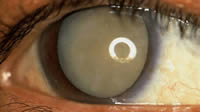Causes and Symptoms
Causes
Cataracts are usually a normal part of the aging process. Cataracts typically develop by the time a person reaches his or her 60s or 70s, although they can occur at younger ages or may exist at birth. Other cataract causes can include eye trauma, inflammation in the eye, or diabetes. Cataracts usually develop in both eyes, but they may develop at different rates.
Cataracts interfere with vision by scattering light as it passes through the eye to the retina
People commonly misunderstand a cataract to be a “skin” on the eye that must be “peeled off.” A cataract is not a growth, but a normally clear lens inside the eye that has turned cloudy.This cloudiness causes blurred images, loss of contrast, glare, or starbursts.
Symptoms
- Painless blurring of vision
- Sensitivity to light and glare
- Double vision in one eye
- Poor night vision
- Difficulty reading in low light
- Fading or yellowing of color
- Frequent changes in glasses or contact lens prescription





